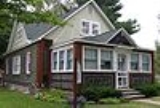
John J. Makinen Bottle House
Encyclopedia
The John J. Makinen Bottle House (also known as the Kaleva Bottle House, Kaleva Bottle House Museum, and Kaleva Historical Museum) is a house built of bottle wall
construction in 1941 by John J. Makinen, Sr. It is located in Kaleva, Michigan
near Manistee
. Construction uses over 60,000 bottles laid on their sides with the bottoms toward the exterior.
 Makinen was a native of Finland
Makinen was a native of Finland
and moved to northwestern Michigan in 1903. He owned and operated the Northwestern Bottling Works Company in Kaleva. He died just before he and his family were to move into the new bottle house.
Most of the bottles came from his bottling plant as the bottom of the bottles reveal. There is a large variety of bottles that were used for many products, including drinks, wine, beer, and liqueur. The bottles were not only round, but oblong in shape as well. The bottles are arranged with clear bottles and brown color bottles on the front of the house to spell "HAPPY HOME."
s, originated in northern Michigan. The museum claims that perhaps it came from the Northwestern Bottling Works Company. It turns out in the early bottling techniques the beverage in its bottle with the cork could not withstand the pressure of the carbonation. On occasion then the cork would blow out of the bottle from the pressure and a loud "POP" sound would be produced.
. All the kids wanted to see was the bathtub associated with the sock puppet character. They were not all that interested in the bottles as their parents were.
Bottle wall
A bottle wall is a wall made out of glass bottles and binding material.-Bottle Wall Construction:A building construction style which usually uses 1l glass bottles A bottle wall is a wall made out of glass bottles and binding material.-Bottle Wall Construction:A building construction style which...
construction in 1941 by John J. Makinen, Sr. It is located in Kaleva, Michigan
Kaleva, Michigan
Kaleva is a village in Manistee County in the U.S. state of Michigan. The population was 509 at the 2000 census.-Geography:*According to the United States Census Bureau, the village has a total area of , all land.*Kaleva is part of Northern Michigan....
near Manistee
Manistee, Michigan
Manistee is a city in the U.S. state of Michigan. As of the 2000 census, the city population was 6,586. It is the county seat of Manistee County. The name "Manistee" is from an Ojibwe word first applied to the principal river of the county. The derivation is not certain, but it may be from...
. Construction uses over 60,000 bottles laid on their sides with the bottoms toward the exterior.
History

Finland
Finland , officially the Republic of Finland, is a Nordic country situated in the Fennoscandian region of Northern Europe. It is bordered by Sweden in the west, Norway in the north and Russia in the east, while Estonia lies to its south across the Gulf of Finland.Around 5.4 million people reside...
and moved to northwestern Michigan in 1903. He owned and operated the Northwestern Bottling Works Company in Kaleva. He died just before he and his family were to move into the new bottle house.
Most of the bottles came from his bottling plant as the bottom of the bottles reveal. There is a large variety of bottles that were used for many products, including drinks, wine, beer, and liqueur. The bottles were not only round, but oblong in shape as well. The bottles are arranged with clear bottles and brown color bottles on the front of the house to spell "HAPPY HOME."
Museum
The Kaleva Historical Society bought the house in 1980. The Kaleva Historical Museum then purchased it in 1981 for a museum after it was remodeled. The museum includes 19th- and 20th-century items. It also has information on the local area schools, along with local companies and families. It is listed on the National Register of Historical Sites and the Michigan Register of Historical Sites as the plaques in front of the house show.Corking
The term "pop", for carbonated soft drinkSoft drink
A soft drink is a non-alcoholic beverage that typically contains water , a sweetener, and a flavoring agent...
s, originated in northern Michigan. The museum claims that perhaps it came from the Northwestern Bottling Works Company. It turns out in the early bottling techniques the beverage in its bottle with the cork could not withstand the pressure of the carbonation. On occasion then the cork would blow out of the bottle from the pressure and a loud "POP" sound would be produced.
Children
Early in the opening of the Kaleva Bottle House Museum many times the children coming through it wanted to see just the bathroom. It seems that the bathtub had been featured in a Nickelodeon show with a sock puppetSock puppet
A sock puppet is a puppet made from a sock or similar garment. When the manipulator fits a hand into the closed end of the sock, the puppet can be seemingly made to "talk". The puppet's mouth is formed by the region between the sock's heel and toe, with the puppeteer's thumb forming a jaw...
. All the kids wanted to see was the bathtub associated with the sock puppet character. They were not all that interested in the bottles as their parents were.

